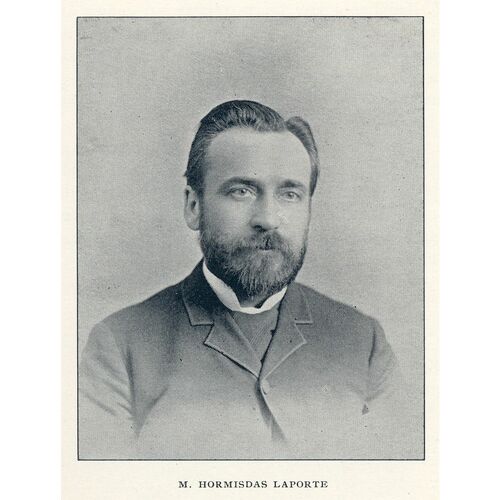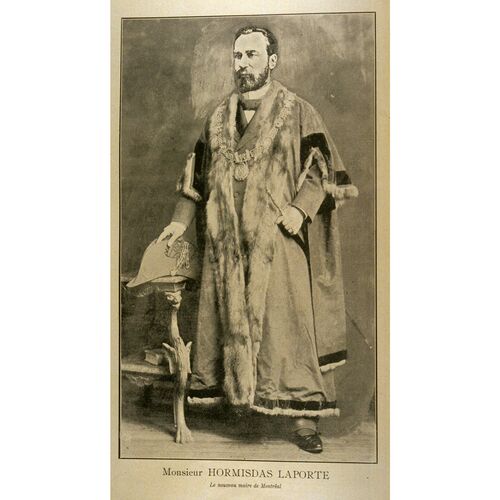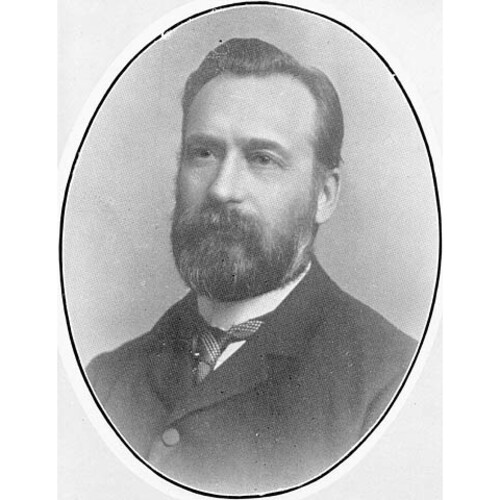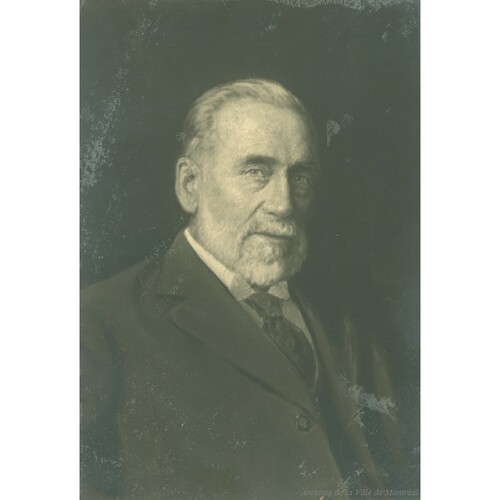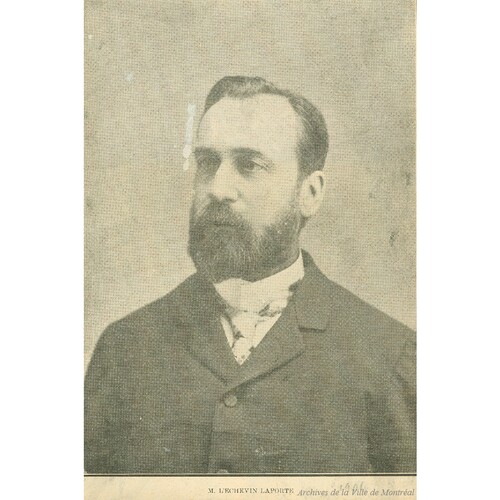LAPORTE, Sir HORMISDAS, businessman, politician, and financier; b. 6 Nov. 1850 in Lachine (Montreal), son of Jean-Baptiste Laporte, a miller, and Marie Jubinville; m. 14 Jan. 1874 Marie-Onésime-Mirza Gervais in Hochelaga (Montreal), and they had a son and a daughter; d. 20 Feb. 1934 in Montreal and was buried there three days later in Notre-Dame-des-Neiges cemetery.
Hormisdas Laporte was one year old when his father, who was then a tradesman, settled with his family at Sault-au-Récollet (Montreal) in a small rented house on the road that ran along the Rivière des Prairies close to the industrial site of the mill dam. Hormisdas received his primary education at the village school. Towards the mid 1860s his family moved to an industrial neighbourhood in Montreal near the Lachine Canal. Hormisdas found employment in an ironworks in the same line of work as his father, who was a nail cutter at the time. He continued in this field until 1870, while also attending evening classes.
In the spring of that year Laporte was hired as a clerk at a Montreal grocery store. It was in the food trade that he would make a name for himself as a businessman and, like a number of French Canadian merchants, he would succeed through his own efforts. With the modest capital he had amassed, he bought the assets of a shop that had gone bankrupt, and in 1870 he opened a grocery store on Rue Saint-Bonaventure (Saint-Jacques), in Saint-Antoine ward. In 1874 he married the daughter of a gentleman in Hochelaga, a small industrial municipality east of Montreal, and relocated his store there. He closed it after a year and moved it back to Saint-Antoine ward. With the help of a loan from an acquaintance, he also started a wholesale firewood business in 1877.
At the beginning of the 1880s Laporte sold his grocery store, whose management he had entrusted to his wife and his sister. Facing competition from coal, he gave up dealing in firewood in 1881 to concentrate on the wholesale food sector. The following year he was able to set up his new commercial venture on Rue Notre-Dame Ouest, in Sainte-Anne ward, with the $3,000 he had accumulated since first going into business. This enterprise, whose location was to change several times, would become increasingly profitable and have earnings that rose from about $50,000 to $300,000 between 1882 and 1885. In January 1888, with the accountant Jean-Baptiste-Albert Martin and the clerk Joseph-Octave Boucher, he founded the wholesale company Laporte, Martin et Compagnie. He was in charge of supplies while Martin handled the firm’s finances. In March 1890, with a view to moving the establishment, the partners bought a lot on Rue Notre-Dame on which stood a Methodist church. A warehouse store was erected there a few months later at a cost of $50,000 and opened in September 1891. To ensure its expansion the company relied on loans from, among others, businessmen Sir Donald Alexander Smith* and Robert Benny. It continued to grow to such an extent that at the beginning of the 1890s its turnover reached $1 million. The firm offered imported grocery products (from Europe, India, the Caribbean, China, and Japan) as well as wine and other alcoholic beverages, which accounted for a sizeable part of its income.
In April 1894 the warehouse store was totally destroyed in a fire that was apparently caused by a fault in the electrical wiring. According to an article in the 27 April issue of La Patrie, the firemen’s efforts were in vain: “Because of the large quantity of alcoholic beverages stored in the building, the flames spread with astonishing rapidity.” To add to the owners’ misfortune, the amount of the damage exceeded the insured value of the assets. Well known for his great perseverance and his ability to finance his projects, Laporte set up his business again over the course of the ensuing weeks in rented premises on Rue Saint-Pierre in the heart of Montreal’s commercial district. It was there that the firm experienced its best years. Indeed, from 1890 to the mid 1920s the company, of which Laporte was the sole manager from 1904, enjoyed a period of strong growth. With the upsurge in its population, Montreal was now recognized as the shipping, railway, commercial, and financial metropolis of the country. As a result, there were numerous business opportunities.
In 1908 the enterprise moved from Rue Saint-Pierre to Rue Saint-Paul, west of McGill Street. The warehouse store continued to expand so that by 1925 it would take up the entire city block. The seven-storey stone and brick building also housed a cold-storage warehouse and offices, and incorporated modern technology such as a steel structure, electric lighting and elevators, ventilation and fire-protection systems, and a telephone service. Over the years the product line became more diversified. The firm distributed its goods in the Montreal region and established a network of branches and warehouses in Quebec and Ontario as well as in the Maritimes. In the 1920s Laporte, Martin, Limitée (the name the company had assumed in 1913) was considered one of the four largest wholesale grocery firms in Canada.
Laporte’s changes of residence are indicative of his rise in social status. From the beginning of the 1880s to the mid 1890s the businessman lived close to his place of work, opposite Saint-Joseph church on Rue Richmond. He then moved to the salubrious districts in the upper part of the city, near Mount Royal. From 1910 he owned a mansion on Rue Dorchester Ouest (Boulevard René-Lévesque).
At the beginning of the 1920s increased competition forced wholesale grocers to reassess their activities. For one thing, the establishment of the Quebec Liquor Commission in 1921, which created a monopoly for the sale of wine and alcoholic beverages, was a heavy blow. “Within a month or two of the announcement [to set up the commission],” Le Devoir would report on 9 Jan. 1926, Laporte’s firm suffered losses representing “fifty per cent of its business.” For another thing, the emergence of grocery chains with their own supply networks led to a reduction in income for the wholesalers. To address these issues, Laporte began marketing products under the company’s own brand name as well as goods other than food, such as furniture and butchery equipment. Furthermore, he made his son, Joseph, responsible for setting up, in 1927, Victoria Independent Stores Limited. This new type of food business, which connected a supplier with affiliated stores, was inspired by the Independent Grocers’ Alliance formed in the United States in 1926. These diversification strategies did not secure the company’s prosperity, and growth tapered off. In 1932 Laporte, Martin, Limitée merged with Hudon, Hébert et Chaput Limitée [see Charles Chaput*] to become Laporte-Hudon-Hébert Limitée.
While pursuing his career, Laporte contributed in various ways to the development of the business and the economic interests of French Canadians. In December 1886 he had been one of the 135 founding members of the Chambre de Commerce du District de Montréal, a francophone association incorporated the next year. He served as its president from 1894 to 1896. In 1892 this group created the Merchants’ Telephone Company of Montreal, of which Laporte was a director. As an influential member of the chamber of commerce, Laporte, along with Alphonse Desjardins*, helped found the École des Hautes Études Commerciales de Montréal in 1907.
Laporte’s expertise and experience were put to good use on other occasions. For example, in December 1892 he had been a co-founder of the Alliance Nationale, a mutual-aid society that had as one of its missions the promotion of the economic, social, moral, and intellectual education of its members and of French Canadians. Incorporated in February 1893, it sought to provide financial assistance to members in difficulty and to pay compensation to their heirs in case of death. Its distinguishing feature was the use of life insurance as capital that was placed at the disposal of French Canadians to develop their businesses. The inaugural meeting was held on 11 Dec. 1892 in the basement of Saint-Joseph church. The first honorary president was the archbishop of Montreal, Édouard-Charles Fabre*. Each charter member contributed $100 towards the establishment of a common fund. By setting up its system of mutuality, the Alliance Nationale, which relied on a strategy of putting down local roots, was a pioneer in French Canada and succeeded in being a counterweight to the life-insurance companies controlled by non-francophone interests. Laporte served as its president from 1892 to 1902, a period of major expansion for the society. Meanwhile, in July 1900 Laporte had been involved in organizing the Banque Provinciale du Canada [see Tancrède Bienvenue; Alphonse Desjardins]. Because of his enterprising and energetic personality, he was elected to the board of directors. From 1907 until a month before his death in 1934 he was president of the institution, which, through its competitive strategy, recorded exceptional growth during the first quarter of the 20th century. Unlike other financial institutions, the Banque Provinciale du Canada invested about half of its capital in purchase options, bonds, stocks, and notes, which proved very lucrative.
Laporte was also active in the political arena. Concerned about the sound management of municipal affairs, he joined the reform movement that was in vogue in large North American cities at the turn of the 20th century. Started by members of the anglophone elite, including a number of businessmen and, in particular, by the industrialist and philanthropist Herbert Brown Ames*, reformism had a limited impact in Montreal. In 1895 Laporte’s involvement in the movement encouraged francophones to take an interest in it. The reformers advocated modern municipal governance based on sound management of the bureaucracy, and especially of public finances. Controlling public debt, fighting corruption, and developing a transparent policy of tendering contracts in the interests of the taxpayers were the main planks of their platform.
In February 1897 Laporte was appointed an alderman for Montreal’s Centre ward to replace a representative who had resigned. In the provincial election held that May he ran for the Conservative Party in the riding of Hochelaga, but did not win a seat. Subsequently, he was elected three times – in 1898, 1900, and 1902 – as an alderman, an office he held until he became mayor in 1904. As the francophone leader of the reform movement, which wanted to put an end to the political machine installed by Mayor Raymond Préfontaine* (who awarded large contracts for roads arbitrarily to maintain his popularity) and to bring public spending under control, he took on duties that included chairing, from 1900 to 1904, the city of Montreal’s finance committee, which was charged with exercising closer oversight of public spending and the awarding of contracts. A handful of reform candidates were returned in 1898, and the group grew substantially in the election of 1900, when, with 16 aldermen, it came close to forming a majority. Its popularity continued at the polls in 1902, but declined after that.
In the election held in the winter of 1904, Laporte ran for the mayoralty of Montreal. During this campaign the reformers launched a debate on bringing public services (mass transit, electricity, gas, and telephone) under municipal control, while denouncing the big public utilities that profited from lucrative contracts which gave them a monopoly. Newspapers such as La Patrie and La Presse supported Laporte’s candidacy and on 1 February he was elected with an overwhelming majority of 12,500 votes. His opponent, Ucal-Henri Dandurand*, the “candidate of the trusts,” as Robert Rumilly* would describe him in his Histoire de la province de Québec, received fewer than half the number of the winner’s votes. The next day, La Patrie wrote, “Mr Laporte is the choice of every race and every class, of the West as of the East, of Liberals as of Conservatives.”
The challenges that Laporte and the reformers on council wanted to take up were numerous. Apart from upgrading public services and reducing their cost, the tasks included cleaning the streets, improving parks, and providing assistance to people suffering from contagious diseases (especially tuberculosis, which was rampant at the time). Laporte took the office of mayor for a two-year term. Because of health problems – during his last year as mayor, illness prevented him from taking part in municipal council meetings – he did not run for office in the 1906 election. Another motive for his retirement from Montreal politics was his support for the tacit principle of alternating English- and French-speaking mayors. In the speech he wrote on 8 Feb. 1906 in St Augustine, Fla, where he was convalescing, he recalled that the objectives of putting the city’s finances in order and increasing its revenues were achieved by annexing the municipality of Villeray and the densely settled towns of Saint-Henri and Sainte-Cunégonde. During his mayoralty the population of Montreal had thus increased by more than 40,000. In January 1907 the municipal council honoured him by changing the name of Avenue du Parc, in the former town of Saint-Henri, to Laporte. On 20 Feb. 1934, in La Presse, Joseph-Étienne Gauthier, the city clerk, would describe Laporte as “a worthy and competent mayor. He had a better knowledge of local-government affairs than all those around him, and as a financial administrator he always held sensible views. In municipal life he was a figure of towering stature.”
Laporte continued to be very active in the Montreal reform movement as a member of the Association of Citizens, which brought together reformers in 1909 and 1910. Their efforts led in 1909 to the royal commission to make a general and complete inquiry into the administration of the affairs of the city of Montreal, chaired by judge Lawrence John Cannon*. The compromising revelations of corruption on the part of the sitting aldermen that the inquiry reported worked to the advantage of the reform candidates. On 1 Feb. 1910 they assumed power at City Hall, winning a majority of the council seats and the mayoralty, taken by James John Edmund Guerin. The following day, in La Patrie, Laporte commented on the election, delighting in, among other things, the rapprochement between the two linguistic communities. “The Association of Citizens, which wanted a sound and progressive administration, has succeeded in putting its candidates in office with strong majorities. This result will be greatly appreciated by businessmen of both nationalities, who, united in a single purpose, the progress of Montreal, were not held back by the cry of race that was hurled at the candidates of the Réforme-Municipale party. As a citizen of Montreal and a French Canadian, I am happy to note that my compatriots, in this instance, have provided Canadians of another race and another language with an example of tolerance and conciliation. I am convinced that those who were elected today will make Montreal one of the most prosperous cities in America.”
The reformers’ term in office at Montreal City Hall ended in failure. The municipality continued to experience financial problems, and living conditions remained precarious for a number of its inhabitants. Economically, the annexationist strategy proved to be nothing but smoke and mirrors. The integration of the debt-ridden suburban towns increased the financial burden on taxpayers. Nevertheless, Laporte and the reformers left as their legacy a concept of municipal management that fostered the separation of executive and political powers. From 1910 the executive reported to the new board of commissioners [see Lawrence John Cannon], while the council maintained its legislative prerogatives. A keen fisherman, Laporte owned a summer residence at Dorion (Vaudreuil-Dorion), where he had been a municipal councillor (1891–94 and 1901–4) and mayor in 1904.
In the course of his career Laporte was able to put his administrative abilities to good use in a number of ways. He became a justice of the peace in 1885. Ten years later he was a member of the Montreal Harbour Commission. Appointed governor for life of the Hôpital Général and Notre-Dame Hospital, he was a director of several Montreal firms, including the Life Insurance Company La Sauvegarde, the newspaper La Patrie, and the Crédit Foncier Franco-Canadien. He was also on the board of the Canadian Northern Railway Company and president of the Dominion Wholesale Grocers’ Guild. At the request of the Conservatives, he sat on the War Purchasing Commission [see Sir Albert Edward Kemp*] from its creation on 8 May 1915 and served as its chairman from 10 Nov. 1917 to 31 July 1920. Well known for his honesty and integrity, Laporte, who was entrusted by the Canadian government with controlling colossal expenditures, had to ensure transparency in management and avoid favouritism. Following the armistice he resigned from his post, which he had taken up without remuneration.
Laporte’s sense of social and political commitment earned him several distinctions. In 1910 McGill University granted him an honorary lld to recognize his involvement in reforming the municipal administration of Montreal. On 13 Nov. 1917, as a reward for services rendered, he was appointed to the Privy Council in London, even though he had never been a minister or an mp. The following year King George V made him a member of the Order of the Bath for his exceptional contributions and on 26 June he was knighted.
A respected businessman, described in La Patrie on the day after his mayoral victory as a “distinguished citizen,… a decent man who has faithfully devoted himself to the public good,” Laporte was also active in various social causes. From 1903 to 1906 he was a member of the Montreal Catholic School Commission and the St Vincent de Paul Society of Montreal. For several years he held diverse positions (treasurer, president) with charitable organizations in Saint-Joseph parish, with which he always maintained close ties. From 1905 to 1907 he chaired the Association Saint-Jean-Baptiste de Montréal. His network of connections extended far beyond the region of Montreal, as his affiliation with groups in Ottawa and New York City demonstrates.
A widower from the age of 62 – his wife died on 29 March 1913, at 58 – Laporte continued to work until his death at 83. He was also predeceased by his daughter. At his funeral in Westmount’s Saint-Léon church, hundreds of dignitaries and prominent figures paid tribute to him. The presence of local, provincial, and federal politicians, senators, heads of companies, bankers, and merchants brought to mind all the spheres of activity with which he had been associated during his extremely full professional life.
Sir Hormisdas Laporte’s career was similar to that of numerous middle-class men of his era. He had his first success in the wholesale food business, and then diversified his business relationships. It was only natural that he would enter the public arena, where he took the high office of mayor of Montreal. Although Laporte associated with the great figures in French Canadian finance, he established ties with anglophone reformers and tried to transform a municipal governance corrupted by patronage. Even though the reform movement was not free of contradictions – close ties to the business world probably explained the timidity of some measures and the failure of the fight against the trusts – Laporte’s real and genuine contribution was acknowledged. Though unsuccessful, the battle against the public-service monopolies showed the distance that businessmen felt impelled to go with respect to the public good.
Guy Mongrain and Sébastien Darchen conducted research for this biography.
BANQ-CAM, CE601-S2, 14 janv. 1874; CE601-S8, 9 nov. 1850; CN601-S301, 12 janv. 1874. Bureau de la Publicité des Droits (Québec), Greffes, W. H. Cox, 24 août 1910; Rosaire Dupuis, 2 avril 1941; G. R. W. Kittson, 20 mars 1890; Moïse Longtin, 20 janv. 1886; William de Montmollin Marler, 4 déc. 1891; J.‑A. Pérodeau, 20 mars 1933; E. H. Stuart, 16 juill. 1894. LAC, R233-32-7, Canada East, dist. Montréal (18), subdist. Sault aux Récollets (239): 65. VM-SA, VM6, D026.27 (dossier Hormisdas Laporte); R3571 (dossier Avenue Laporte). L’Album universel (Montréal), 24 mai 1902, 6 févr. 1904. Le Canada (Montréal), 9 janv. 1906. Le Devoir, 15 août 1925; 9 janv. 1926; 1er août 1928; 20, 22, 23 févr. 1934. Gazette (Montreal), 17 Dec. 1920. Le Monde illustré (Montréal), 5 mai 1894. Le Moniteur du commerce (Montréal), 8 avril 1910. La Patrie, 27, 30 avril 1894; 10 juill. 1900; 2 févr. 1904; 3 janv. 1905; 12 févr. 1906; 2, 3 févr. 1910. La Presse, 12 févr. 1902, 11 déc. 1920, 22 févr. 1934. Directory, Montreal, 1850–1934. Gabrielle Cloutier, “Hormidas Laporte (1850–1934): une petite maison, un grand homme,” Cahiers d’hist. du Sault-au-Récollet, no.4 (automne 1993): 8–10. Michèle Dagenais, Democracy in Montréal from 1830 up to the present (Montreal, 1992); Des pouvoirs et des hommes: l’administration municipale de Montréal, 1900–1950 ([Montréal et Kingston, Ontario], 2000). [Gaspard Dauth et J.‑A.‑S. Perron], Le diocèse de Montréal à la fin du dix-neuvième siècle … (Montréal, 1900). Annie Desaulniers, “Le secours mutuel en transformation: l’Alliance nationale (1892–1948)” (mémoire de ma, univ. du Québec à Trois-Rivières, Québec, 2002). J.‑C. Lamothe, Histoire de la corporation de la cité de Montréal depuis son origine jusqu’à nos jours … (Montréal, 1903). Linteau, Hist. de Montréal. C.‑V. Marsolais et al., Histoire des maires de Montréal (Montréal, 1993). Newspaper reference book. Que., National Assembly, “History”: www.assnat.qc.ca/en/patrimoine/index.html (consulted 8 Oct. 2010). Canadian men and women of the time (Morgan; 1898). Fernande Roy, Progrès, harmonie, liberté: le libéralisme des milieux d’affaires francophones de Montréal au tournant du siècle (Montréal, 1988). Ronald Rudin, Banking en français: the French banks of Quebec, 1835–1925 (Toronto, 1985). Rumilly, Hist. de Montréal, vol.4. [Télesphore Saint-Pierre], Histoire du commerce canadien-français de Montréal, 1535–1893 (Montréal, 1894).
Cite This Article
Claire Poitras, “LAPORTE, Sir HORMISDAS,” in Dictionary of Canadian Biography, vol. 16, University of Toronto/Université Laval, 2003–, accessed December 28, 2025, https://www.biographi.ca/en/bio/laporte_hormisdas_16E.html.
The citation above shows the format for footnotes and endnotes according to the Chicago manual of style (16th edition). Information to be used in other citation formats:
| Permalink: | https://www.biographi.ca/en/bio/laporte_hormisdas_16E.html |
| Author of Article: | Claire Poitras |
| Title of Article: | LAPORTE, Sir HORMISDAS |
| Publication Name: | Dictionary of Canadian Biography, vol. 16 |
| Publisher: | University of Toronto/Université Laval |
| Year of publication: | 2018 |
| Year of revision: | 2018 |
| Access Date: | December 28, 2025 |


![M. Hormisdas Laporte [image fixe] Original title: M. Hormisdas Laporte [image fixe]](/bioimages/w600.7667.jpg)
